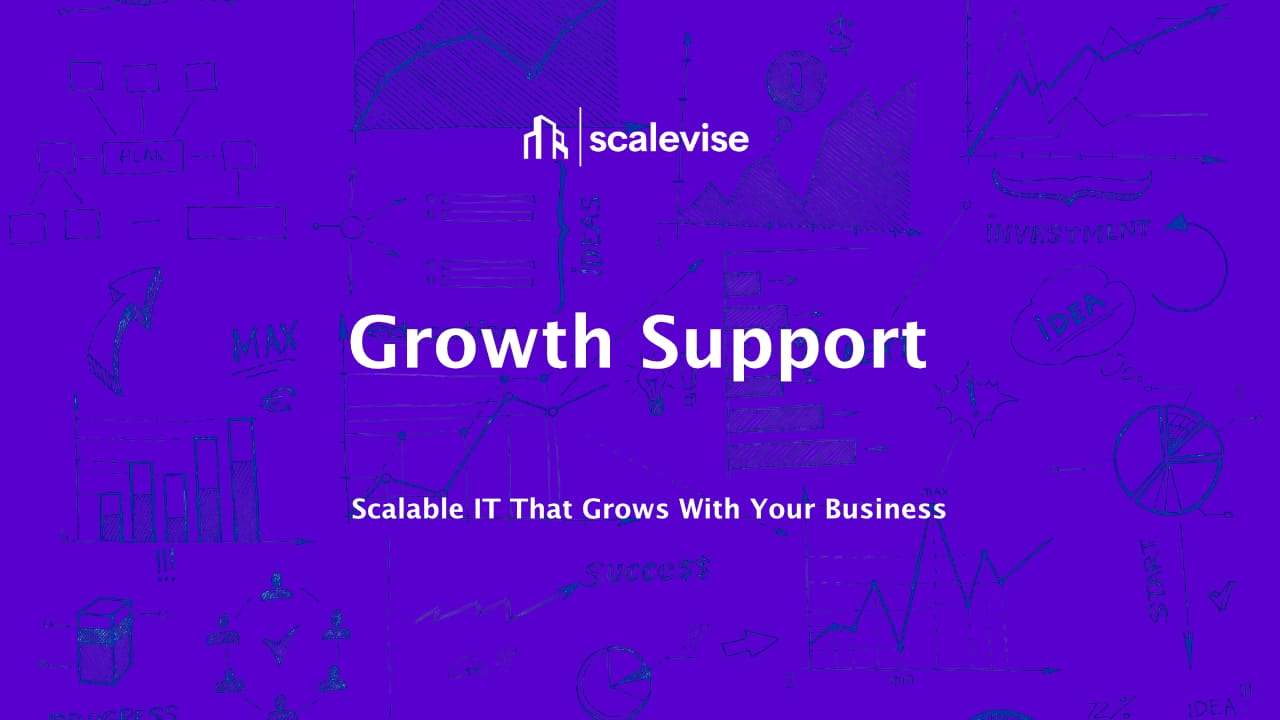Growth Support: Scalable IT That Grows With Your Business

When companies talk about growth, the focus is often on sales, hiring, or expanding into new markets. What’s overlooked? The IT foundation that makes this growth possible. Without scalable IT, expansion quickly turns into chaos: systems collapse under new workloads, onboarding slows down, and innovation grinds to a halt.
This article explores how scalable IT works, why it matters, and how businesses can build systems that grow seamlessly alongside their ambitions.
What Is Scalable IT?
Scalable IT is about designing technology that adapts as your company evolves. Rather than tearing down and rebuilding infrastructure every time your business expands, scalable systems flex with demand.
Core characteristics of scalable IT:
- Resources increase or decrease without disruption.
- New users, services, or workloads can be added on demand.
- Integration of new platforms is smooth, not a bottleneck.
Think of it as a growth-ready foundation: your business can add new departments, enter new markets, or launch new products without outgrowing its technology.
Why Scalability Is Critical for Growth
Business growth comes with unpredictable spikes in demand. Without scalability, IT systems buckle under pressure.
Problems companies face when IT doesn’t scale:
- Performance bottlenecks: Customer portals slow down, websites crash, or data systems time out.
- Inefficient onboarding: Each new hire creates manual setup work and delays.
- Mounting costs: Constant migrations or “patchwork fixes” eat up budgets.
- Missed opportunities: Teams can’t launch new initiatives fast enough to capture market share.
Scalable IT removes these barriers. Instead of being a roadblock, your IT becomes a growth accelerator.
The Strategic Role of Scalable IT
IT should not just support growth — it should drive it. A well-architected, scalable infrastructure lets you:
- Expand markets faster without technology rework.
- Increase agility by experimenting with new tools and services quickly.
- Lower long-term costs by avoiding constant rebuilds.
- Protect compliance as regulations and risks evolve.
In many cases, scalable IT is the difference between surviving growth and capitalizing on it.
Growth Stages and IT Requirements
Different phases of growth demand different IT strategies. Let’s break it down.
1. Startup Stage
Focus is on agility and quick wins. No-code platforms and SaaS tools provide speed. At this stage, businesses often use workflow automation to streamline repetitive tasks.
2. Scale-Up Stage
The organization doubles in size, customer demand spikes, and complexity rises. Now IT must handle integrations between CRM, ERP, and financial systems. Middleware and hybrid approaches become essential. Our guide on AI workflow automation at scale explains how to handle these transitions.
3. Corporate Stage
Here, performance, compliance, and resilience dominate. Custom infrastructure, advanced security, and cloud-native architectures ensure systems stay reliable across global operations.
Key Components of Scalable IT
- Cloud Infrastructure
Cloud services offer elastic scalability. Adding compute power or storage is as simple as adjusting a slider. No need for expensive hardware upgrades. - Data Architecture
Scalable IT requires data pipelines that grow with volume. Without it, analytics become inaccurate and slow. - Integrations & Middleware
Systems must talk to each other. APIs, connectors, and custom middleware ensure smooth scaling. See our article on code vs no-code automation for deeper insights. - Workflow Automation
Manual processes cannot scale. Automated onboarding, reporting, and monitoring free teams to focus on higher-value work. - Security & Compliance
Growth amplifies risk. Scalable IT includes role-based access, compliance checks, and governance frameworks that adapt as teams expand.
Real-World Examples
- E-commerce expansion: A retailer doubled its online sales during a seasonal peak. Scalable cloud hosting absorbed traffic without downtime, and automated stock management kept logistics under control.
- International growth: A SaaS company entered new markets. A scalable CRM integration allowed different currencies and tax rules without rebuilding the core system.
- Team scaling: A consultancy grew from 15 to 80 employees. Automated onboarding workflows cut setup time from 3 hours per employee to 15 minutes.
Common Pitfalls of Non-Scalable IT
- Short-term thinking: Choosing quick, cheap tools that cannot scale later.
- Over-customization: Locking into rigid systems that resist integration.
- Ignoring data growth: Databases that work for 10,000 records collapse at 1 million.
- Reactive scaling: Waiting until systems fail before upgrading.
These pitfalls cost time, money, and customer trust.
Hybrid Scalability: No-Code and Code Together
A pure no-code stack may work early on but won’t sustain enterprise growth. On the other hand, a fully coded system may be overkill for small workflows. The best strategy? Hybrid scalability:
- Use no-code for repetitive, fast-changing workflows.
- Deploy code automation for high-volume, compliance-critical systems.
This blend ensures speed today and resilience tomorrow.
Building a Scalable IT Roadmap
Step 1: Assess current bottlenecks
Identify where growth is being slowed by IT (storage, onboarding, integrations).
Step 2: Prioritize quick wins
Start with no-code or SaaS solutions to relieve pressure.
Step 3: Design long-term architecture
Plan for middleware, data pipelines, and cloud infrastructure.
Step 4: Automate aggressively
Eliminate manual processes through workflow automation.
Step 5: Govern & secure
Add compliance and monitoring frameworks as you scale.
Scalevise’s Role in Growth Support
At Scalevise, we specialize in building automation and IT strategies that scale. From automated onboarding to full-stack integrations, we ensure your systems evolve with your ambitions.
We deliver:
- Rapid prototyping with no-code tools.
- Robust, custom middleware for mission-critical systems.
- Real-time dashboards and reporting for executive insight.
- Compliance and governance baked into every solution.
Conclusion
Growth is exciting but only if your IT can keep up. Scalable IT ensures that new hires, clients, and services are opportunities, not bottlenecks. By combining no-code speed with code-based resilience, businesses build infrastructures that expand seamlessly with demand.
👉 Contact Scalevise today to design your scalable IT roadmap. Let’s make sure your technology grows at the same pace as your business.
